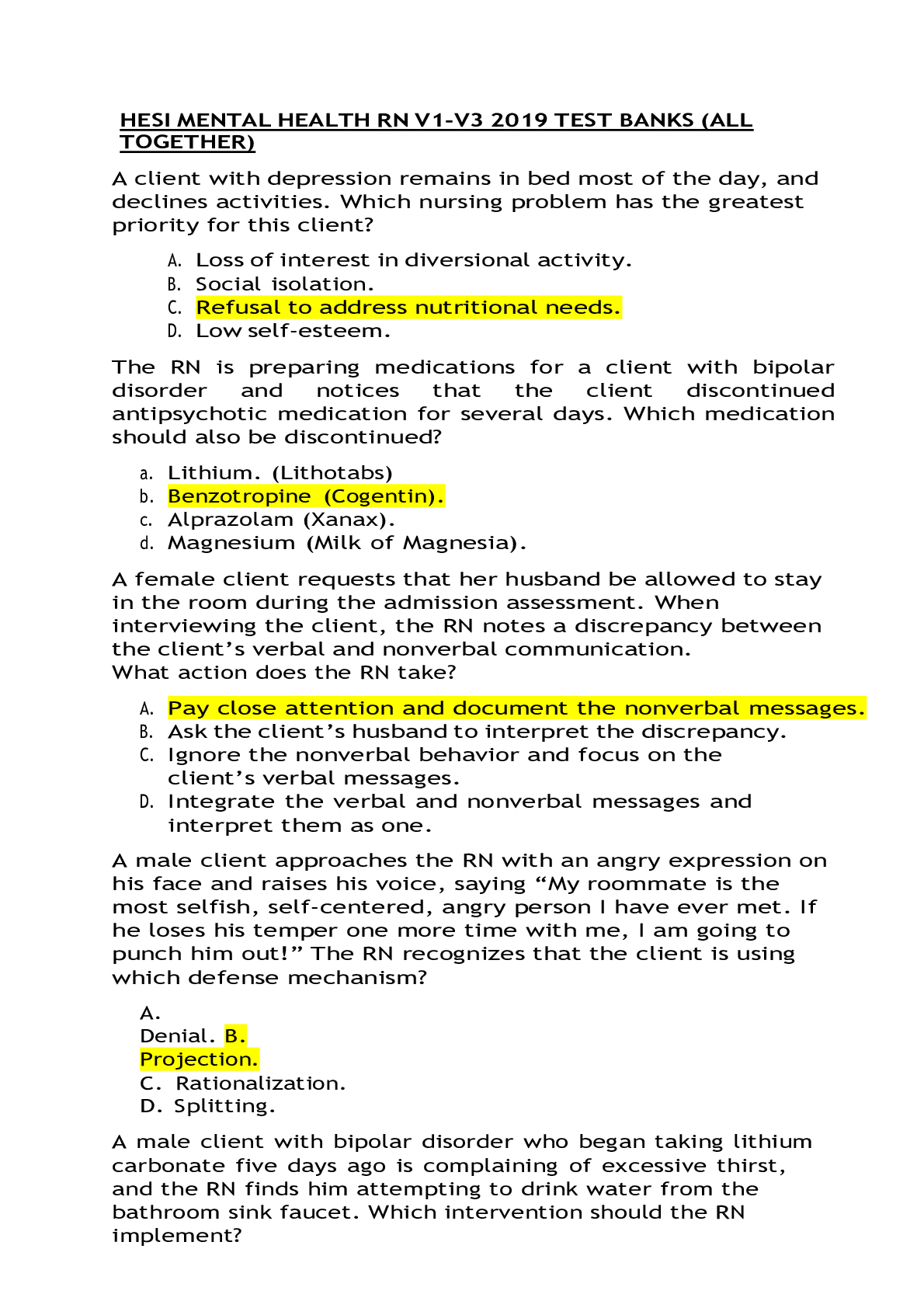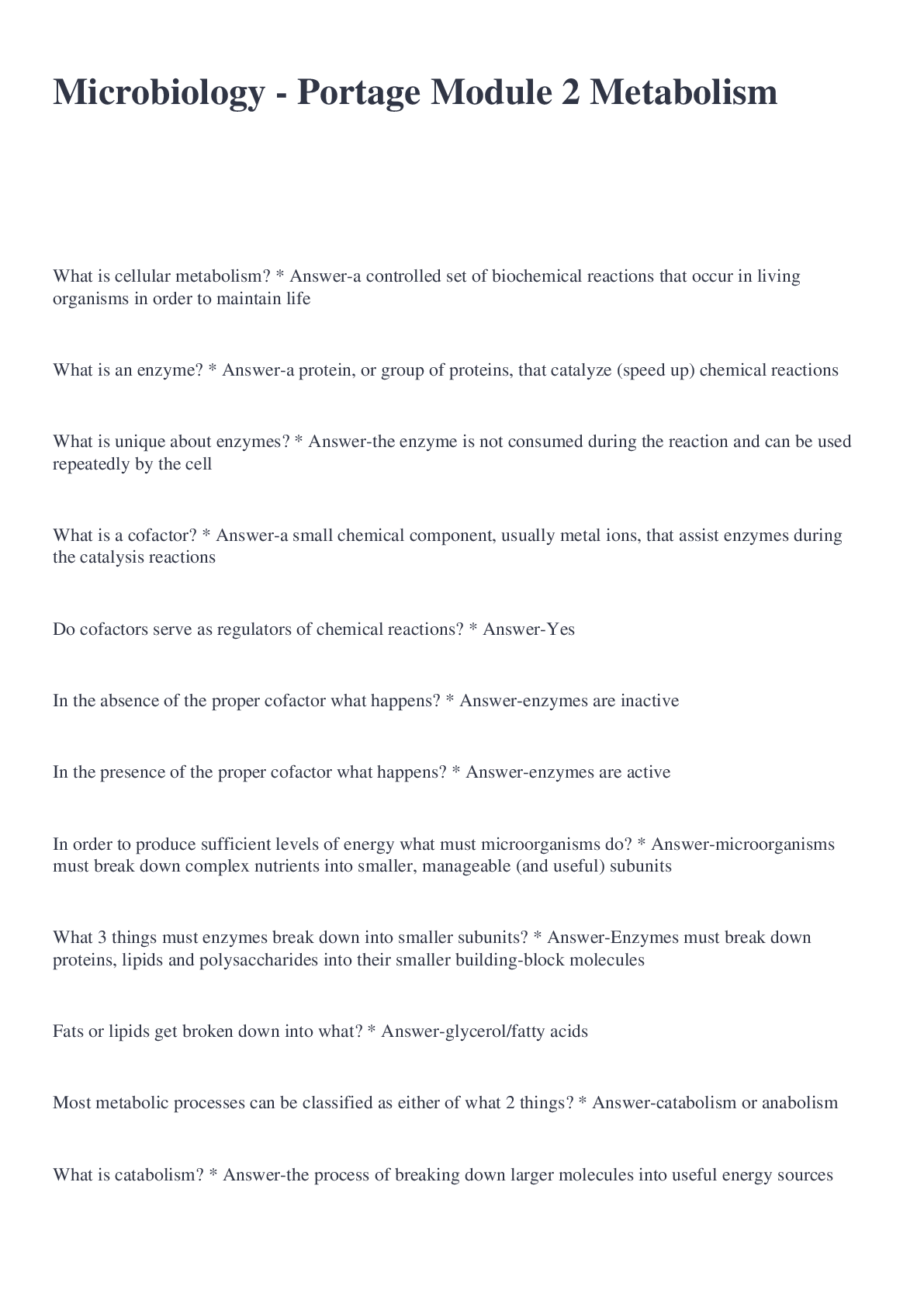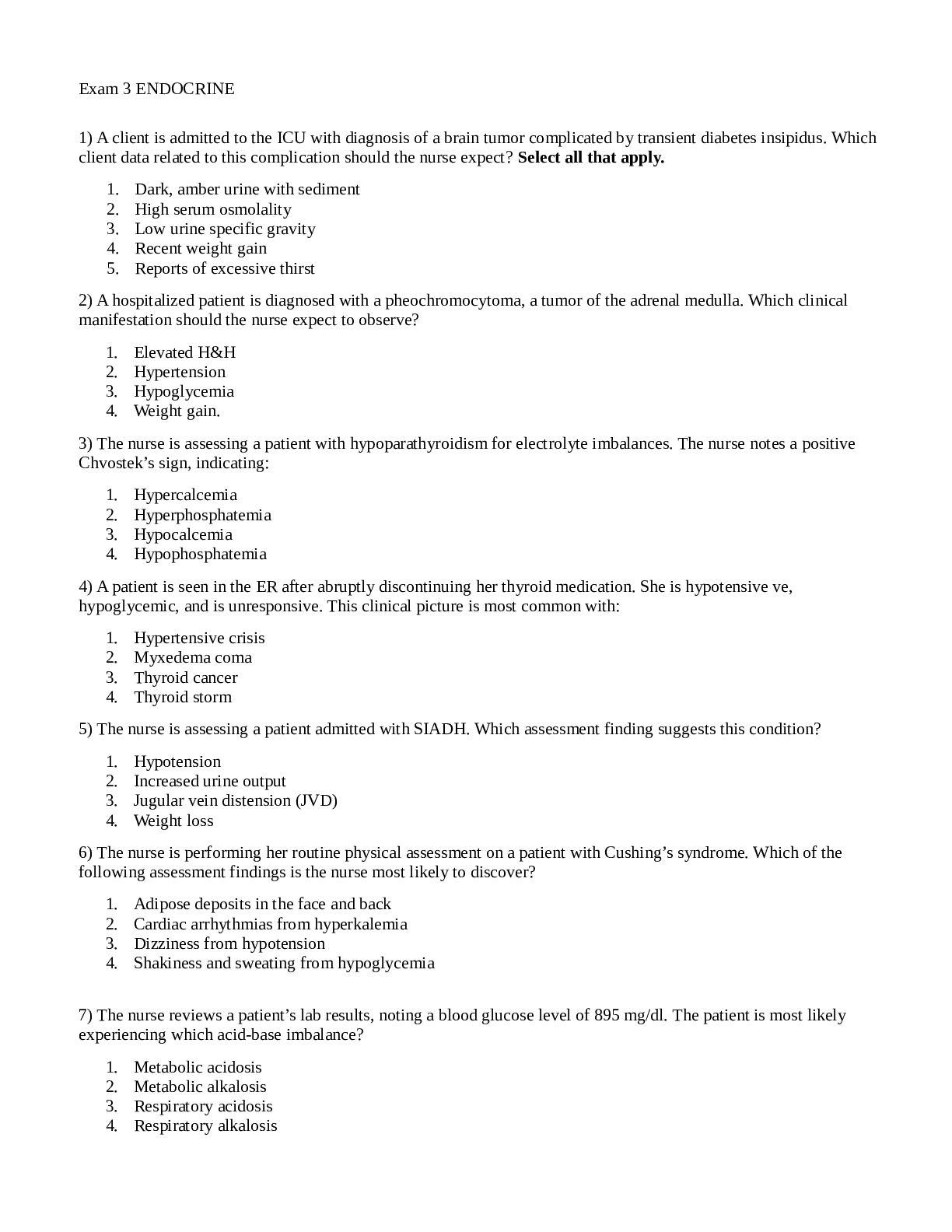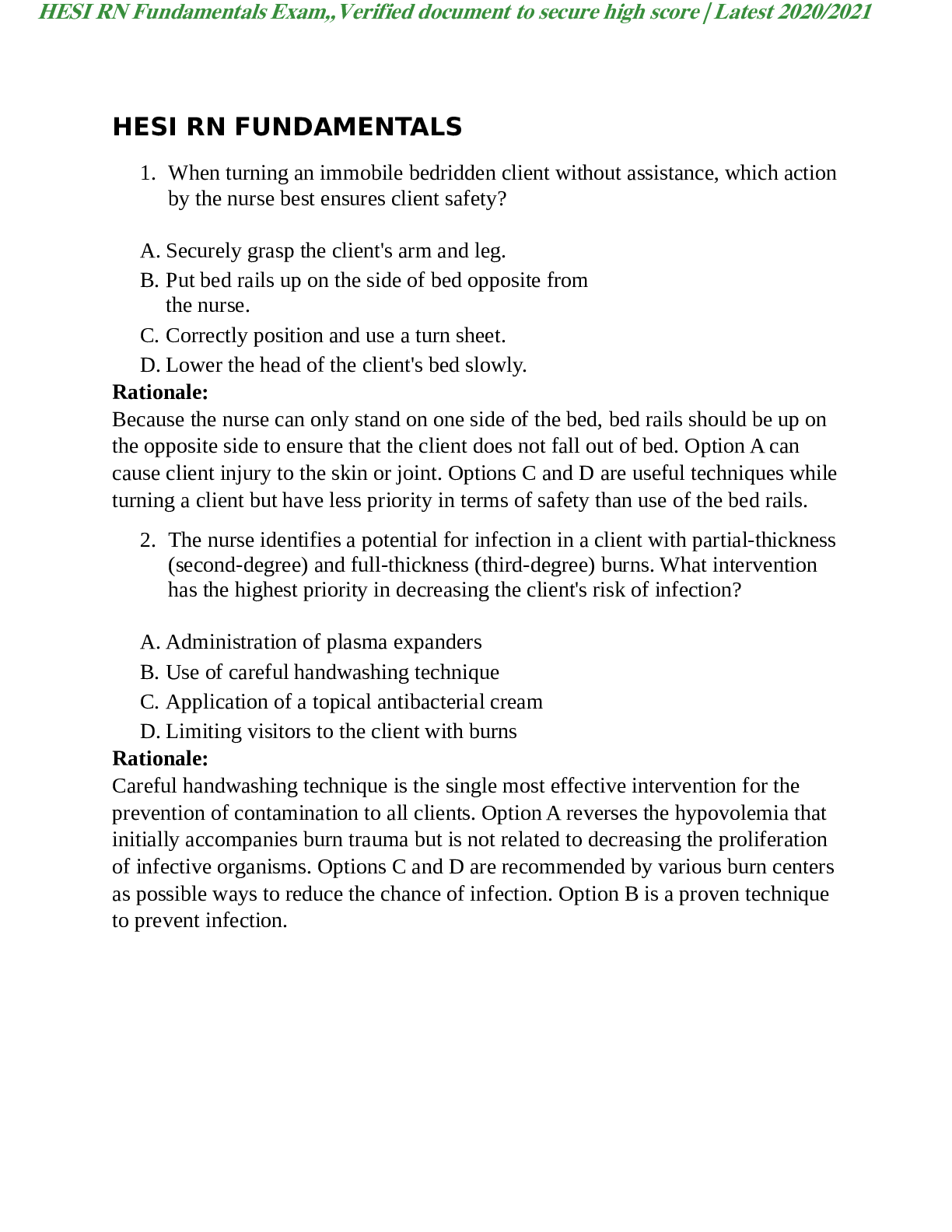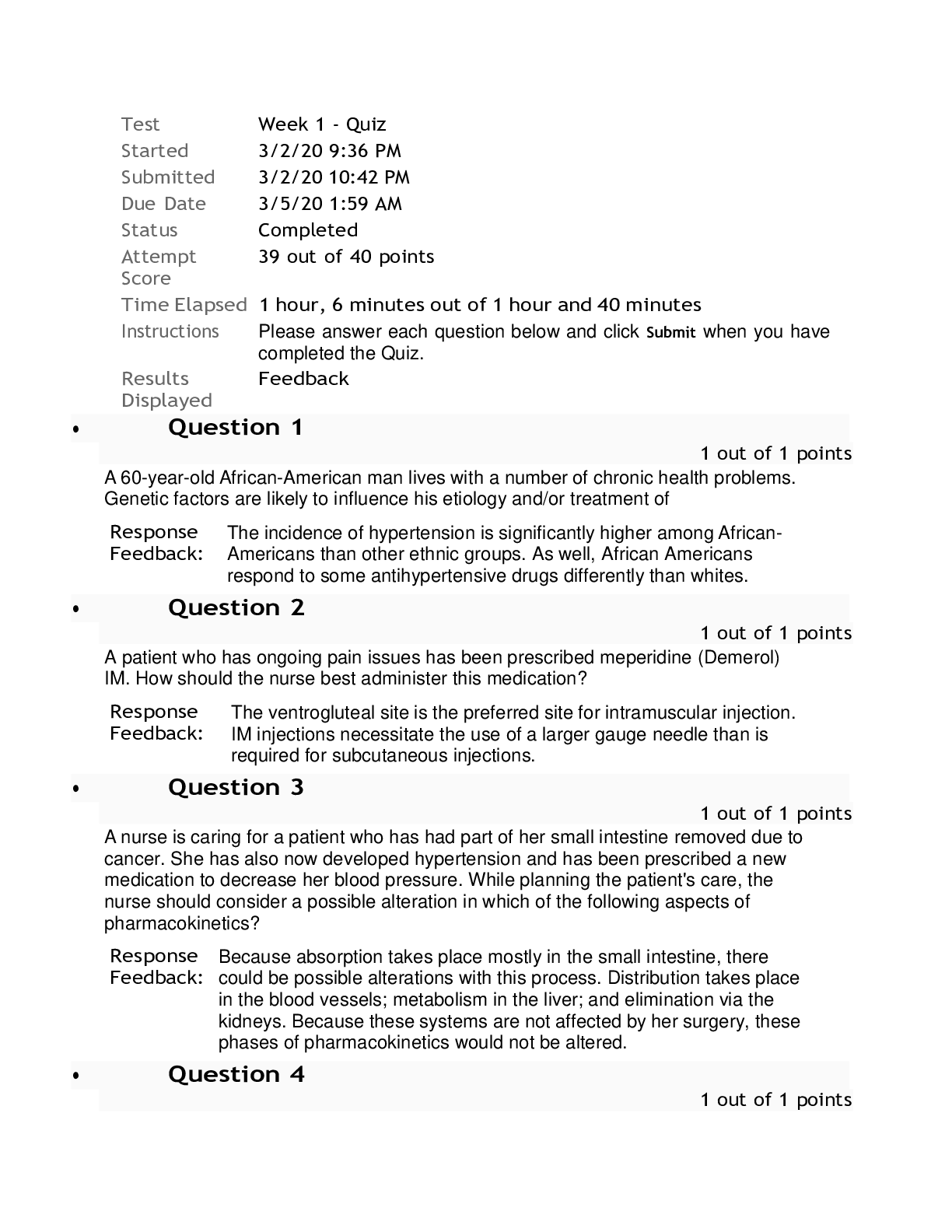*NURSING > QUESTIONS & ANSWERS > MEDSURG_ TEST_Exam_1_ (All)
MEDSURG_ TEST_Exam_1_
Document Content and Description Below
CHAPTER 8 – PAIN 1. Which question asked by the nurse will give the most information about the patient's metastatic bone cancer pain? a. "How long have you had this pain?" b. "How would you desc... ribe your pain?" c. "How often do you take pain medication?" d. "How much medication do you take for the pain?" 2. A patient who has had good control for chronic pain using a fentanyl (Duragesic) patch reports rapid onset pain at a level 9 (0 to 10 scale) and requests "something for pain that will work quickly." How will the nurse document the type of pain reported by this patient? a. Somatic pain c. Neuropathic pain b. Referred pain d. Breakthrough pain 3. The nurse teaches a student nurse about the action of ibuprofen. Which statement, if made by the student, indicates that teaching was effective? a. "The drug decreases pain impulses in the spinal cord." b. "The drug decreases sensitivity of the brain to painful stimuli." c. "The drug decreases production of pain-sensitizing chemicals." d. "The drug decreases the modulating effect of descending nerves." 4. A nurse assesses a patient with chronic cancer pain who is receiving imipramine (Tofranil) in addition to long-acting morphine (MS Contin). Which statement, if made by the patient, indicates to the nurse that the patient is receiving adequate pain control? a. "I'm not anxious during the day." b. "Every night I get 8 hours of sleep." c. "I can accomplish activities without much discomfort." d. "I feel less depressed since I've been taking the Tofranil." 5. A patient with chronic back pain has learned to control the pain with the use of imagery and hypnosis. The patient's spouse asks the nurse how these techniques work. Which response by the nurse is accurate? a. "The strategies work by affecting the perception of pain." b. "These techniques block the pain pathways of the nerves." c. "These strategies prevent transmission of stimuli from the back to the brain." d. "The therapies slow the release of chemicals in the spinal cord that cause pain." 6. A patient who is receiving sustained-release morphine sulfate (MS Contin) every 12 hours for chronic pain experiences level 9 (0 to 10 scale) breakthrough pain and anxiety. Which action by the nurse is appropriate for treating this change in assessment? a. Suggest amitriptyline 10 mg orally. b. Administer lorazepam (Ativan) 1 mg orally. c. Give ibuprofen (Motrin) 400 to 800 mg orally. d. Offer immediate-release morphine 30 mg orally. 7. A patient with chronic neck pain is seen in the pain clinic for follow-up. To evaluate whether the pain management is effective, which question is best for the nurse to ask? a. "Has there been a change in pain location?" b. "Can you describe the quality of your pain?" c. "How would you rate your pain on a 0 to 10 scale?" d. "Does the pain keep you from activities that you enjoy?" 8. A patient with a deep partial thickness burn has been receiving hydromorphone through patient-controlled analgesia (PCA) for 1 week. The nurse caring for the patient during the previous shift reports that the patient wakes up frequently during the night complaining of pain. What action by the nurse is appropriate? a. Administer a dose of morphine every 1 to 2 hours from the PCA machine while the patient is sleeping. b. Consult with the health care provider about using a different treatment protocol to control the patient's pain. c. Request that the health care provider order a bolus dose of morphine to be given when the patient awakens with pain. d. Teach the patient to push the button every 10 minutes for an hour before going to sleep, even if the pain is minimal. 9. The nurse assesses that a patient receiving epidural morphine has not voided for more than 10 hours. What action should the nurse take initially? a. Place an indwelling urinary catheter. b. Monitor for signs of narcotic overdose. c. Ask if the patient feels the need to void. d. Encourage the patient to drink more fluids. 10. The nurse assesses that a home hospice patient with terminal cancer who complains of severe pain has a respiratory rate of 11 breaths/min. Which action should the nurse take? a. Inform the patient that increasing the morphine will cause the respiratory drive to fail. b. Tell the patient that additional morphine can be administered when the respirations are 12. c. Titrate the prescribed morphine dose up until the patient indicates adequate pain relief. d. Administer a nonsteroidal antiinflammatory drug (NSAID) to improve patient pain control. 11. The nurse is completing the medication reconciliation form for a patient admitted with chronic cancer pain. Which medication is of most concern to the nurse? a. Amitriptyline 50 mg at bedtime b. Ibuprofen 800 mg 3 times daily c. Oxycodone (OxyContin) 80 mg twice daily d. Meperidine (Demerol) 25 mg every 4 hours* 12. Which medication should the nurse administer for a patient with cancer who describes the pain as "deep, aching and at a level 8 on a 0 to 10 scale"? a. Ketorolac tablets b. Fentanyl (Duragesic) patch c. Hydromorphone (Dilaudid) IV d. Acetaminophen (Tylenol) suppository 13. The nurse is caring for a patient who has diabetes and complains of chronic, burning leg pain even when taking oxycodone (OxyContin) twice daily. Which prescribed medication is the best choice for the nurse to administer as an adjuvant to decrease the patient's pain? a. Aspirin b. Amitriptyline c. Celecoxib (Celebrex) d. Acetaminophen (Tylenol)* 14. A patient who uses a fentanyl (Duragesic) patch for chronic abdominal pain caused by ovarian cancer asks the nurse to administer the prescribed hydrocodone tablets, but the patient is asleep when the nurse returns with the medication. Which action is best for the nurse to take? a. Wake the patient and administer the hydrocodone. b. Wait until the patient wakes up and reassess the pain. c. Suggest the use of nondrug therapies for pain relief instead of additional opioids. d. Consult with the health care provider about changing the fentanyl (Duragesic) dose. 15. The following medications are prescribed by the health care provider for a middle-aged patient who uses long-acting morphine (MS Contin) for chronic back pain but still has ongoing pain. Which medication should the nurse question? a. Morphine b. Dexamethasone c. Pentazocine (Talwin) d. Celecoxib (Celebrex) 16. The nurse is caring for a patient who had abdominal surgery yesterday and is receiving morphine through patient-controlled analgesia (PCA). What action by the nurse is a priority? a. Assessing for nausea b. Auscultating bowel sounds c. Checking the respiratory rate d. Evaluating for sacral redness* 17. A patient who has fibromyalgia reports pain at level 7 (0 to 10 scale). The patient tells the nurse, "I feel depressed because I ache too much to play golf." Which patient goal has the highest priority when the nurse is developing the treatment plan? a. The patient will report pain at a level 2 of 10. b. The patient will be able to play a round of golf. c. The patient will exhibit fewer signs of depression. d. The patient will say that the aching has decreased. 18. A patient who has just started taking sustained-release morphine sulfate (MS Contin) for chronic arthritic joint pain after a traumatic injury complains of nausea and abdominal fullness. Which action should the nurse take initially? a. Administer the ordered antiemetic medication. b. Order the patient a clear liquid diet until the nausea decreases. c. Tell the patient that the nausea should subside in about a week. d. Consult with the health care provider about using a different opioid. 19. A patient with terminal cancer-related pain and a history of opioid abuse complains of breakthrough pain 2 hours before the next dose of sustainedrelease morphine sulfate (MS Contin) is due. Which action should the nurse take first? a. Use distraction by talking about things the patient enjoys. b. Suggest the use of alternative therapies such as heat or cold. c. Administer the prescribed PRN immediate-acting morphine. d. Consult with the doctor about increasing the MS Contin dose. 20. Which nursing action could the nurse delegate to unlicensed assistive personnel (UAP) when caring for a patient who is using a fentanyl (Duragesic) patch and a heating pad for treatment of chronic back pain? a. Check the skin under the heating pad. b. Count the respiratory rate every 2 hours. c. Ask the patient whether pain control is effective. d. Monitor sedation using the sedation assessment scale. 21. A patient who is using both a fentanyl (Duragesic) patch and immediaterelease morphine for chronic cancer pain develops new-onset confusion, dizziness, and a decrease in respiratory rate. Which action should the nurse take first? a. Remove the fentanyl patch. b. Obtain complete vital signs. c. Notify the health care provider. d. Administer prescribed PRN naloxone 22. The nurse reviews the medication orders for an older patient with arthritis in both hips who reports level 3 (0 to 10 scale) hip pain while ambulating. Which medication should the nurse offer as initial therapy? a. Naproxen 200 mg orally b. Oxycodone 5 mg orally c. Acetaminophen 650 mg orally d. Aspirin (acetylsalicylic acid) 650 mg orally 23. The nurse on a surgical inpatient unit is caring for several patients. Which patient should the nurse assess first? a. Patient with postoperative pain who received morphine sulfate IV 15 minutes ago b. Patient who received hydromorphone (Dilaudid) 1 hour ago and is currently asleep c. Patient who was treated for pain just prior to return from the postanesthesia care unit d. Patient with neuropathic pain who is scheduled to receive a dose of hydrocodone (Lortab) now CHAPTER 15 - CANCER A patient who is scheduled for a right breast biopsy asks the nurse the difference between a benign tumor and a malignant tumor. Which answer by the nurse is correct? a. "Benign tumors do not cause damage to other tissues." b. "Benign tumors are likely to recur in the same location." c. "Malignant tumors may spread to other tissues or organs." d. "Malignant cells reproduce more rapidly than normal cells." The nurse is caring for a patient receiving intravesical bladder chemotherapy. The nurse should monitor for which adverse effect? a. Nausea b. Alopecia c. Mucositis d. Hematuria The nurse is caring for a patient who smokes 2 packs/day. To reduce the patient's risk of lung cancer, which action by the nurse is best? a. Teach the patient about the seven warning signs of cancer. b. Plan to monitor the patient's carcinoembryonic antigen (CEA) level. c. Discuss the risks associated with cigarettes during every patient encounter. d. Teach the patient about the use of annual chest x-rays for lung cancer screening. The nurse should include which food choice when providing dietary teaching for a patient scheduled to receive external beam radiation for abdominal cancer? a. Fresh fruit salad b. Roasted chicken c. Whole wheat toast d. Cream of potato soup During a routine health examination, a 40-year-old patient tells the nurse about a family history of colon cancer. Which action should the nurse take next? a. Teach the patient about the need for a colonoscopy at age 50. b. Teach the patient how to do home testing for fecal occult blood. c. Obtain more information from the patient about the family history. d. Schedule a sigmoidoscopy to provide baseline data about the patient. A patient who is diagnosed with cervical cancer that is classified as Tis, N0, M0 asks the nurse what the letters and numbers mean. Which response by the nurse is most appropriate? a. "The cancer involves only the cervix." b. "The cancer cells look almost like normal cells." c. "Further testing is needed to determine the spread of the cancer." d. "It is difficult to determine the original site of the cervical cancer." The nurse teaches a patient who is scheduled for a prostate needle biopsy about the procedure. Which statement, if made by the patient, indicates that teaching was effective? a. "The biopsy will remove the cancer in my prostate gland." b. "The biopsy will determine how much longer I have to live." c. "The biopsy will help decide the treatment for my enlarged prostate." d. "The biopsy will indicate whether the cancer has spread to other organs." The nurse teaches a postmenopausal patient with stage III breast cancer about the expected outcomes of cancer treatment. Which patient statement indicates that the teaching has been effective? a. "After cancer has not recurred for 5 years, it is considered cured." b. "The cancer will be cured if the entire tumor is surgically removed." c. "Cancer is never considered cured, but the tumor can be controlled with surgery, chemotherapy, and radiation." d. "I will need to have follow-up examinations for many years after I have treatment before I can be considered cured." A patient with a large stomach tumor that is attached to the liver is scheduled to have a debulking procedure. Which information should the nurse teach the patient about the outcome of this procedure? a. Pain will be relieved by cutting sensory nerves in the stomach. b. Relief of pressure in the stomach will promote better nutrition. c. Tumor growth will be controlled by the removal of malignant tissue. d. Tumor size will decrease and this will improve the effects of other therapy. External-beam radiation is planned for a patient with cervical cancer. What instructions should the nurse give to the patient to prevent complications from the effects of the radiation? a. Test all stools for the presence of blood. b. Maintain a high-residue, high-fiber diet. c. Clean the perianal area carefully after every bowel movement. d. Inspect the mouth and throat daily for the appearance of thrush. A patient with Hodgkin's lymphoma who is undergoing external radiation therapy tells the nurse, "I am so tired I can hardly get out of bed in the morning." Which intervention should the nurse add to the plan of care? a. Minimize activity until the treatment is completed. b. Establish time to take a short walk almost every day. c. Consult with a psychiatrist for treatment of depression. d. Arrange for delivery of a hospital bed to the patient's home. The nurse is caring for a patient with colon cancer who is scheduled for external radiation therapy to the abdomen. Which information obtained by the nurse would indicate a need for patient teaching? a. The patient swims a mile 3 days a week. b. The patient snacks frequently during the day. c. The patient showers everyday with a mild soap. d. The patient has a history of dental caries with amalgam fillings. A patient undergoing external radiation has developed a dry desquamation of the skin in the treatment area. The nurse teaches the patient about management of the skin reaction. Which statement, if made by the patient, indicates the teaching was effective? a. "I can buy some aloe vera gel to use on the area." b. "I will expose the treatment area to a sun lamp daily." c. "I can use ice packs to relieve itching in the treatment area." d. "I will scrub the area with warm water to remove the scales." [Show More]
Last updated: 2 years ago
Preview 1 out of 22 pages

Buy this document to get the full access instantly
Instant Download Access after purchase
Buy NowInstant download
We Accept:

Reviews( 0 )
$32.50
Can't find what you want? Try our AI powered Search
Document information
Connected school, study & course
About the document
Uploaded On
May 07, 2021
Number of pages
22
Written in
Additional information
This document has been written for:
Uploaded
May 07, 2021
Downloads
0
Views
125

.png)
 HESI VI EXIT EXAM.png)
